Vehicle-to-everything (V2X) technology
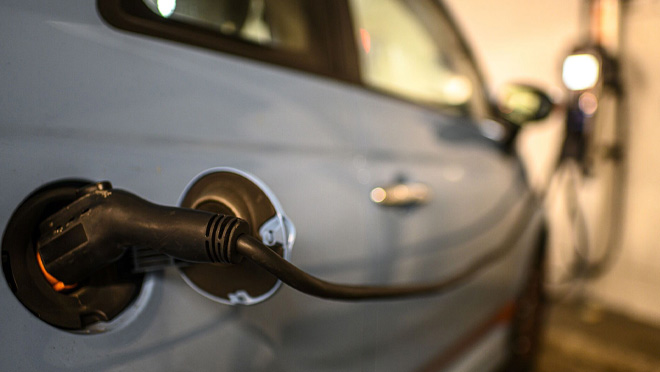
Unlock the power of a bidirectional charging system, explore the potential of your EV
Vehicle-to-everything (V2X) is an emerging technology in the world of electric vehicles (EVs). V2X enables EVs to do more than store energy to power your drive, they also serve as energy reserves and providers through a bidirectional charger.
On this page:
What's V2X
The V2X concept broadly covers opportunities where electric vehicles are more than just for transportation. It encompasses how an electric vehicle can power your home, help electric utilities operate the grid more efficiently and communicate with other vehicles and transportation infrastructure to improve traffic management.
While V2X is an umbrella term to cover all use cases of this technology, there are other terms and acronyms to represent more specific applications.
Vehicle-to-grid (V2G) specifically refers to technology that connects the electric vehicle with the power grid. These applications are most relevant to BC Hydro, for purposes like load balancing, backup power for customers in power outages, and optional reward programs for customers who use it to reduce their peak power usage or to send power back to the grid.
Here are some other terms related to V2X technology that you might see:
- Vehicle-to-home (V2H)
- Vehicle-to-building (V2B)
- Vehicle-to-load (V2L)
Benefits of V2X technology
EVs with V2X technology can become an energy source, helping to power buildings, devices and even the grid. Learn more about the benefits of V2X below.
Resilience and energy independence
Emergency power during outage
Many people have experienced the inconvenience of a power outage, but with a bidirectional charging EV, your vehicle's battery can act as a backup power source.
Whether you need to power a few key appliances, your entire home or your building, your EV's battery provides you with peace of mind during emergencies.
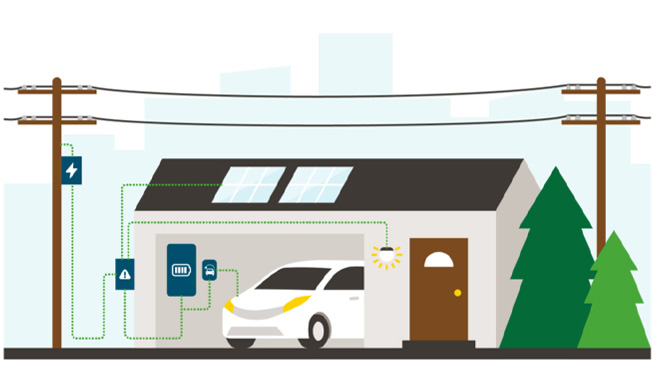
Store your self-generated renewable energy
If you have a generation system, like solar panels, energy generated by the solar panels can be stored in an EV's battery for use later. Whether for your home or business, your EV's battery can act as a reservoir and allow you to choose when to use the stored power based on what's most beneficial.
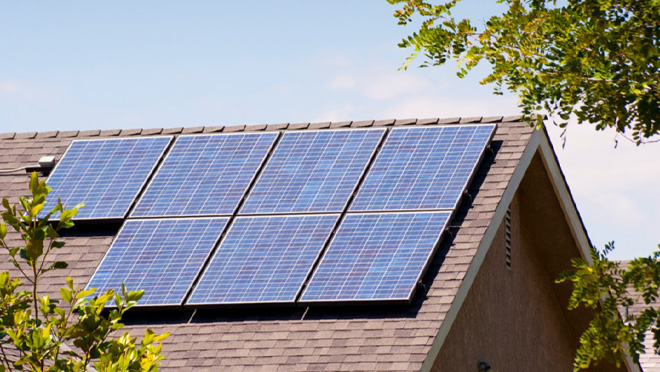
Financial benefits
Reduce on-peak energy costs
If you're on a time-of-day rate plan, you can save money with V2X by using your vehicle's stored energy during on-peak hours.
Similarly, if you're on a rate plan with demand charges, you can use your vehicle's stored energy to reduce your peak demand and lower your demand charge.
Helps you earn demand-response program rewards
V2X-equipped EVs can contribute electricity back to the grid during times of high demand, helping us manage the demand. By participating in demand-response programs, you can receive financial rewards for helping us balance the grid. V2X makes it easier for both individuals and businesses to succeed at those programs.

Avoid panel upgrades
By utilizing the energy storage capability of your EV's battery, you may be able to avoid costly electric service upgrades. During times of high demand, the EV battery can power appliances or reduce the load on your main electrical panel, avoiding the need for expensive upgrades.
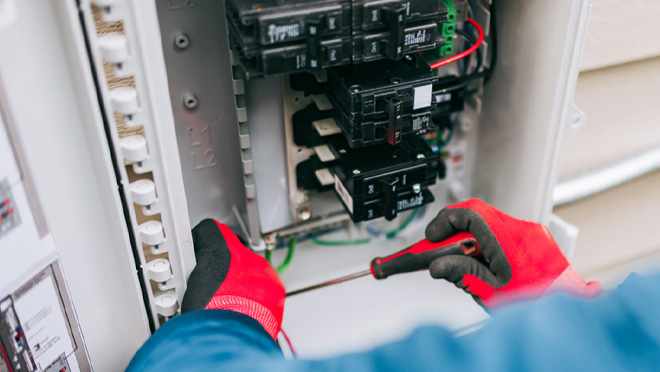
Driving towards a net-zero future
V2X technology plays a crucial role in helping us move toward a net-zero future. With the ability to store renewable energy and provide power when needed, EVs will be even more of a key component in creating a sustainable and energy-efficient world.
The (near) future of V2X
V2X programs are still a few years away from being widely available. In 2023 we undertook Canada's first vehicle-to-grid pilot project for medium and heavy-duty vehicles. We successfully tested a 60-kilowatt charger connecting a Lion Electric school bus from Lynch Bus Lines injecting into the grid.
As of 2025, we're continuing to test vehicles, equipment and use cases with our customers and partners.
As V2X-capable vehicles become more common, we'll explore and develop participation opportunities for our customers. These opportunities would align well with our demand response programs, which offer incentives and rewards for shifting energy use outside of peak demand periods.
In the meantime, explore the demand response programs we already offer:
Residential customer offers
Business customer offers
Participants in any future V2X programs would be expected to be connected to our Distributed Energy Resource Management System (DERMS). The DERMS will signal the vehicles to charge and discharge in response to grid needs, including:
- Weather conditions
- Locational constraints
- Emergency events
- System needs
V2X participating equipment would receive signals through onboard vehicle telematics, connected EV chargers, and building automation systems.
V2X-equipped EV models
Not all EVs have the V2X functionality built in, but as the technology evolves, the list of vehicles equipped with V2X features continues to expand.
Here's a look at some vehicles and chargers that feature V2X capabilities as of April 2025. This list isn't comprehensive, so we recommend confirming information with manufacturers. The list of vehicles and chargers are expected to change over time, and we’ll update it semi-annually to reflect the latest developments.
Vehicle*
| Light duty models | Medium- and heavy-duty models |
|---|---|
| Nissan Leaf (2022 and newer) | Navistar International |
| Ford F-150 Lightning | Ford F-Series Super Duty (2024 and newer) |
| Honda Prologue (2024) | Freightliner (eCascadia, M2 106) |
| Hyundai Ioniq 5 and Ioniq 6 | Peterbilt (Model 220, 579) |
| Kia EV6 | Hino (Series 195, 268, 338) |
| Chevrolet Silverado EV RST | Volvo Trucks (Mack and Volvo) |
*Select trims and battery types
Charger
| Residential chargers | Commercial chargers |
|---|---|
| Wallbox Quasar 2 | Fermata Energy FE-15 |
| Ford Charge Station Pro | Fermatat Energy FE-20 |
| GM Energy PowerShift Charger and GM Energy V2H Enablement Kit | Tellus Power Green TP5-XX-480-V2G-1 (XX=30, 40, 60) |
| Borgwarner RES-DCVC60 |
Installation information for contractors
For contractors, electricians, or vendors assisting customers with V2X installations, here are key considerations for interconnecting to BC Hydro.
- Emergency power: To connect an EV to a building's main or emergency sub-panel for use during outages typically doesn't require BC Hydro coordination. This is a non-parallel connection. A bi-directional charger is required.
- Energy management: For peak load reduction and time-varying rate optimization, a parallel connection is used. Coordination with BC Hydro is required and must meet the interconnection application requirements.
- V2G: Injecting power into the grid requires BC Hydro coordination and must follow the Distributed Generation Guidelines [PDF, 599 KB].
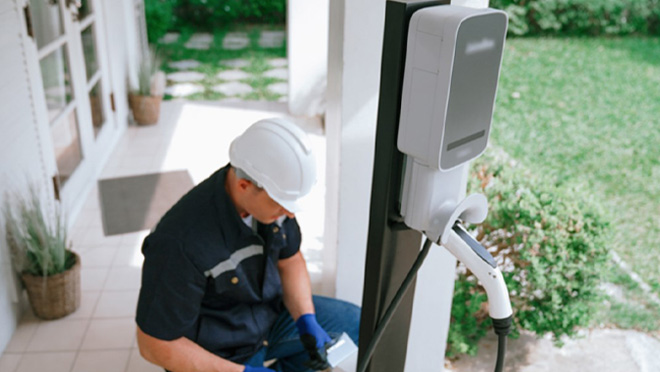
Process to connect your V2X vehicle and charger
When connecting a V2X-enabled vehicle to the grid, it's important to follow the proper interconnection process to ensure safety and compliance.
Below is a table to help clarify the key differences between the connection requirements.
| Requirements for connections | |
|---|---|
| V2G (Vehicle to Grid) V2G technology enables electric vehicles to send stored energy back to the grid. |
Requires special chargers, permitting, and interconnection requirements. |
| V2H (Vehicle to Home) V2H technology allows EVs to supply power back to a home. |
Requires a less sophisticated vehicle and charger than for V2G, plus a transfer switch for energy flow control. |
For V2X, BC Hydro has specific interconnection requirements based on the type of connection (V2G or V2H).
Depending on the intended use case, the EV battery operates in four states. State A involves charging the battery with no generator interconnection required. Similarly, State B represents a disconnected emergency mode for outage support. This state also requires no generator interconnection and minimal review.
State C refers to the battery being connected in parallel, often as part of utility programs to reduce peak energy usage, lower costs, and shift energy use, this setup can fit within existing non-exporting small generator interconnection frameworks.
Finally, State D involves feeding power into the grid, which can be accommodated within existing exporting small generator interconnection frameworks. These states are important because each has different connection requirements, including electrical safety devices, the application process, study costs, and wait times for approvals.
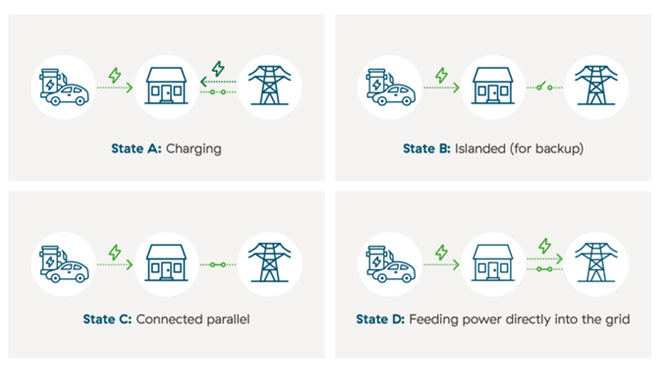
Contact us
V2X is an emerging technology for us and our customers. Do you have a question we haven't answered? Help us improve our V2X information by sending us your feedback or unanswered question by email.
Sign up for email updates
If you'd like to receive updates about current or upcoming V2X initiatives or information, please fill out the form below.
Fields marked with * are required.
BC Hydro is collecting your personal information (specifically, name, email, and vehicle make) and will be used to contact you about current and future initiatives. It will be stored outside of Canada. Collection is authorized under Section 26(c) of the Freedom of Information and Protection of Privacy Act (FIPPA) of British Columbia. If you have any questions about how your personal information is handled, please contact demo@bchydro.com.